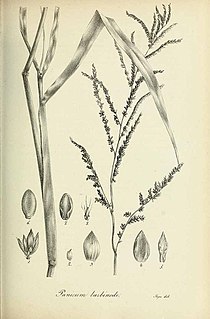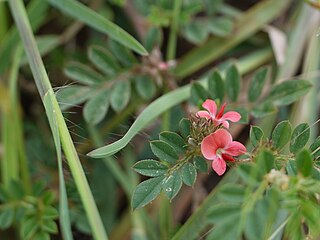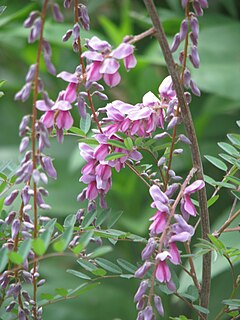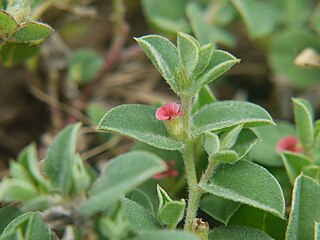
Indigo is a deep color close to the color wheel blue, as well as to some variants of ultramarine, based on the ancient dye of the same name. The word "indigo" comes from the Latin for Indian as the dye was originally exported to Europe from India.

Indigo dye is an organic compound with a distinctive blue color. Historically, indigo was a natural dye extracted from the leaves of some plants of the Indigofera genus, in particular Indigofera tinctoria; dye-bearing Indigofera plants were commonly grown and used throughout the world, in Asia in particular, as an important crop, with the production of indigo dyestuff economically important due to the previous rarity of some blue dyestuffs historically.

Indigofera is a large genus of over 750 species of flowering plants belonging to the pea family Fabaceae. They are widely distributed throughout the tropical and subtropical regions of the world.

Indigofera tinctoria, also called true indigo, is a species of plant from the bean family that was one of the original sources of indigo dye. It has been naturalized to tropical and temperate Asia, as well as parts of Africa, but its native habitat is unknown since it has been in cultivation worldwide for many centuries. Today most dye is synthetic, but natural dye from I. tinctoria is still available, marketed as natural coloring where it is known as tarum in Indonesia and nila in Malaysia. In Iran and areas of the former Soviet Union it is known as basma. The plant is also widely grown as a soil-improving groundcover.

Indigofera suffruticosa, commonly known as Guatemalan indigo, small-leaved indigo, West Indian indigo, wild indigo, and anil, is a flowering plant in the pea family, Fabaceae.

Baptisia is a genus in the legume family, Fabaceae. They are flowering herbaceous perennial plants with pea-like flowers, followed by pods, which are sometimes inflated. They are native to woodland and grassland in eastern and southern North America. The species most commonly found in cultivation is B. australis.

Atriplex semibaccata, the Australian saltbush, berry saltbush, or creeping saltbush, is native to Australia, commonly found in coastal regions from South Australia all the way up to Cardwell in Queensland. It is a prostrate growing ground cover plant of the family Amaranthaceae that grows to around 180 cm wide, and flowers year round. Leaves small, olive to grey-green. Insignificant flowers, in small clusters in leaf axil. Flowers during summer. Fruit is flattened, diamond-shaped, orange to red. It is tolerant of saline and dry conditions making it commonly used as an animal feed source in poorer agricultural areas: it is grazed by livestock, and birds are fond of its fruits. It is also a good species for erosion control.

Indigofera australis, the Australian indigo or Austral indigo, is an attractive species of leguminous shrub in the genus Indigofera. The genus name Indigofera is Neo-Latin for "bearing Indigo". Australis, from the Latin, means not “Australian” but "southern", referring to the geographical distribution of the species.

Indigofera heterantha, commonly known as Himalayan indigo, is a species of flowering plant in the legume family Fabaceae. It is native to the northwestern Himalayas of Tibet, in Asia.

Brachiaria mutica is a species of grass known by the common names para grass, buffalo grass, Mauritius signal grass, pasto pare, malojilla, gramalote, parana, Carib grass, and Scotch grass. Despite its common name California grass, it does not occur in California; it is native to northern and central Africa and parts of the Middle East, where it is cultivated for fodder. It was introduced elsewhere and it is now cultivated throughout tropical regions of the world for this purpose.

Indigofera linnaei, known as Birdsville indigo and nine-leaved indigo, is a species of leguminous shrub in the genus Indigofera. The genus name, Indigofera, is derived from Latin and means bearing/containing indigo, while linnaei derives from Linnaeus.

Indigofera decora, commonly known as summer wisteria, is a species of shrub native to China and Japan that has since been introduced to Australia and Sri Lanka. A member of the genus Indigofera, its family is Fabaceae and is used primarily for decorative purposes, though it has also been used to make indigo-colored dye.

Indigofera pendula, the weeping indigo, is a species of flowering plant in the family Fabaceae, native to south-central China. Its cultivar 'Shangri-la' has gained the Royal Horticultural Society's Award of Garden Merit.

Indigofera hirsuta, the hairy indigo or rough hairy indigo, is a species of flowering plant in the family Fabaceae. It is native to nearly all the world's tropics; South America, Africa, Madagascar, the Indian Subcontinent, southern China, southeast Asia, Malesia, Papuasia and Australia, and has been introduced to the Caribbean, the southeast United States, Mexico and Central America. It is used as a green manure and, to a minor extent, for forage.

Vicia narbonensis, called Narbon bean, Narbon vetch, Narbonne vetch and moor's pea, is a widely distributed species of flowering plant in the family Fabaceae. It is native to Madeira and the Mediterranean countries through to Central Asia and the western Himalayas, and has been introduced to central and eastern Europe, and scattered other locations. It has some palatability issues, but has potential as a green manure and forage crop, and for its beans. It is the namesake of the Vicia narbonensis species complex.

Indigofera cordifolia, the heart-leaf indigo, is a species of flowering plant in the family Fabaceae. It is found from the Cape Verde Islands, across the Sahel to Oman, the Indian Subcontinent, Guangdong in China, and some of the islands of Indonesia, and it has been introduced to the Northern Territory of Australia. A glycophyte adapted to sandy soils, it is considered a weed in some situations, but can also improve crop yields due to its nitrogen-fixing ability.

Grewia bicolor, called bastard brandy bush, false brandy bush, two-coloured grewia, white-leaved grewia, white-leaved raisin, white raisin and donkey berry, is a species of flowering plant in the family Malvaceae, native to Sub‑Saharan Africa, Yemen, Oman, and the Indian Subcontinent. In Africa Grewia bicolor is one of the most important forages during the dry season, when all herbivores, wild and domestic, find it palatable. It is particularly enjoyed by giant eland and domestic goats.
Grewia kakothamnos is a species of flowering plant in the family Malvaceae, found from southern Ethiopia to Tanzania. Its flowers are white to pale lilac, and its two or four-lobed fruit are orange when ripe, and edible in a famine situation. Grewia kakothamnos is particularly enjoyed as a forage by domestic goats, which will even eat the dead fallen leaves during the dry season.

Indigofera spicata, the creeping indigo or trailing indigo, is a species of flowering plant in the family Fabaceae. It is native to Sub‑Saharan Africa, Madagascar, Mauritius, Réunion, and Yemen, and has been introduced to the southeastern United States, various Caribbean islands, Brazil and other locations in Latin America, various Pacific islands, and New South Wales and Queensland in Australia. It was considered to be a promising forage plant, and then shown to be toxic to nearly all livestock, but it is possible that the experiments were conducted on the similar Indigofera hendecaphylla, leading to some confusion.

















